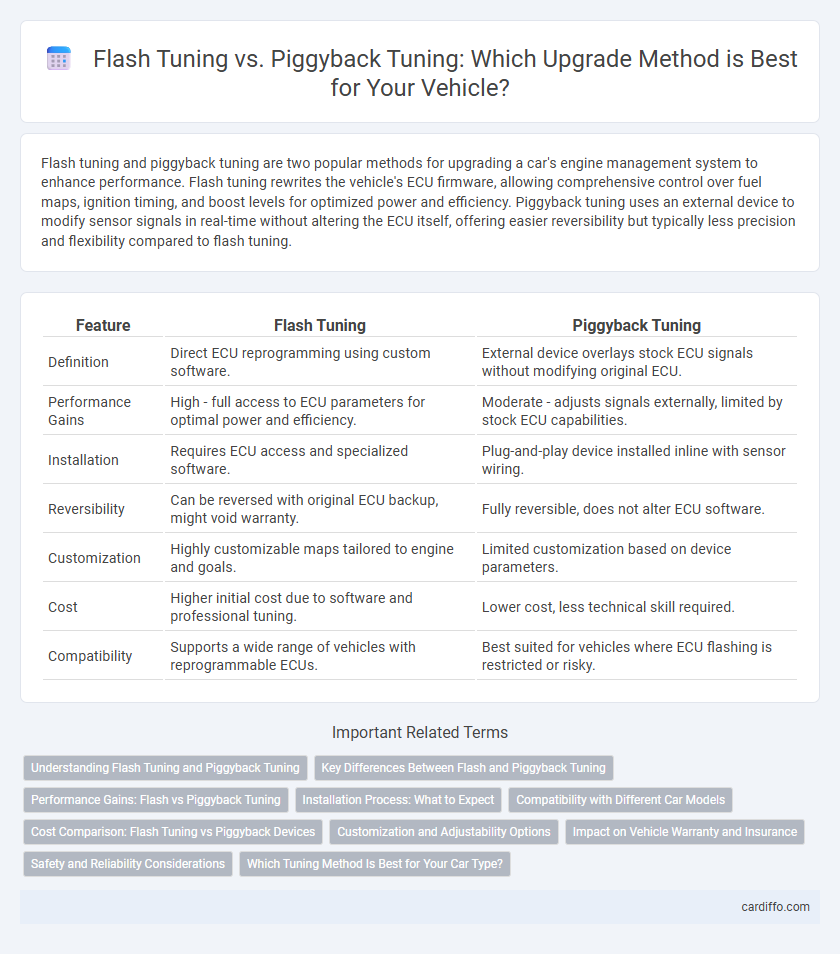Flash tuning and piggyback tuning are two popular methods for upgrading a car's engine management system to enhance performance. Flash tuning rewrites the vehicle's ECU firmware, allowing comprehensive control over fuel maps, ignition timing, and boost levels for optimized power and efficiency. Piggyback tuning uses an external device to modify sensor signals in real-time without altering the ECU itself, offering easier reversibility but typically less precision and flexibility compared to flash tuning.
Table of Comparison
| Feature | Flash Tuning | Piggyback Tuning |
|---|---|---|
| Definition | Direct ECU reprogramming using custom software. | External device overlays stock ECU signals without modifying original ECU. |
| Performance Gains | High - full access to ECU parameters for optimal power and efficiency. | Moderate - adjusts signals externally, limited by stock ECU capabilities. |
| Installation | Requires ECU access and specialized software. | Plug-and-play device installed inline with sensor wiring. |
| Reversibility | Can be reversed with original ECU backup, might void warranty. | Fully reversible, does not alter ECU software. |
| Customization | Highly customizable maps tailored to engine and goals. | Limited customization based on device parameters. |
| Cost | Higher initial cost due to software and professional tuning. | Lower cost, less technical skill required. |
| Compatibility | Supports a wide range of vehicles with reprogrammable ECUs. | Best suited for vehicles where ECU flashing is restricted or risky. |
Understanding Flash Tuning and Piggyback Tuning
Flash tuning involves directly rewriting the vehicle's ECU (Engine Control Unit) firmware to optimize performance parameters such as fuel maps, ignition timing, and boost pressure. Piggyback tuning uses an external controller to intercept and modify sensor signals before they reach the ECU, allowing adjustable performance without altering the original firmware. Understanding the key differences helps determine which method suits specific goals, balancing customization, cost, and reversibility.
Key Differences Between Flash and Piggyback Tuning
Flash tuning rewrites the vehicle's ECU firmware to optimize engine performance, providing comprehensive control over fuel maps, ignition timing, and boost pressure. Piggyback tuning uses an external device to intercept and modify sensor signals between the ECU and engine components, allowing for easier installation and reversibility without altering the original ECU software. While flash tuning offers deeper, more precise adjustments for maximum performance gains, piggyback tuning provides a less invasive, customizable upgrade option ideal for simpler or staged modifications.
Performance Gains: Flash vs Piggyback Tuning
Flash tuning delivers direct ECU remapping for optimized fuel injection and ignition timing, resulting in more significant horsepower and torque increases compared to piggyback tuning. Piggyback tuning modifies sensor signals and adjusts parameters externally, which limits performance gains due to less precise control. Flash tuning's integrated approach enables deeper customization, yielding superior acceleration, throttle response, and overall engine efficiency.
Installation Process: What to Expect
Flash tuning involves directly reprogramming the vehicle's Engine Control Unit (ECU) through a software upload, typically completed within 30 to 60 minutes using specialized diagnostic tools without hardware modifications. Piggyback tuning requires installing an external module between the ECU and sensors, which may take 1 to 2 hours depending on the vehicle's wiring complexity and typically requires manual adjustments or calibration. Both processes demand precise installation to ensure optimal engine performance and avoid potential drivability issues or ECU damage.
Compatibility with Different Car Models
Flash tuning offers broad compatibility with a wide range of car models by directly reprogramming the ECU, allowing precise adjustments for specific engines and configurations. Piggyback tuning, which adds an external module to intercept sensor signals, tends to be more limited in compatibility and may require specialized versions for different makes and models. Choosing between flash and piggyback tuning depends on the vehicle's ECU architecture and the desired level of customization.
Cost Comparison: Flash Tuning vs Piggyback Devices
Flash tuning offers a more cost-effective solution by directly reprogramming the vehicle's ECU, eliminating the need for additional hardware. Piggyback devices incur higher expenses due to the cost of the hardware itself and the complexity of installation. The upfront cost savings of flash tuning are often coupled with better long-term value, as piggyback systems may require ongoing adjustments and maintenance.
Customization and Adjustability Options
Flash tuning provides extensive customization by directly rewriting the ECU's firmware, enabling precise control over fuel maps, ignition timing, and boost pressure for tailored performance enhancements. Piggyback tuning adjusts signals sent to the ECU without altering the original firmware, offering limited adjustability but easier reversibility and compatibility with stock settings. Flash tuning suits enthusiasts seeking deep, permanent modifications, while piggyback systems appeal to those needing flexible, less invasive adjustments.
Impact on Vehicle Warranty and Insurance
Flash tuning modifies the vehicle's ECU firmware directly, which can void manufacturer warranties and increase scrutiny from insurance providers due to altered performance parameters. Piggyback tuning, by adding an external control unit without altering the ECU, often preserves the factory warranty and poses fewer risks for insurance claims. Understanding these differences is crucial for maintaining warranty coverage and minimizing insurance complications after performance upgrades.
Safety and Reliability Considerations
Flash tuning offers enhanced safety and reliability by directly reprogramming the vehicle's ECU, ensuring precise control over engine parameters and reducing compatibility issues. Piggyback tuning, while easier to install, carries higher risks due to potential communication conflicts between the piggyback unit and the stock ECU, which can lead to unforeseen performance problems or system errors. Choosing flash tuning minimizes the chance of data corruption and supports better long-term engine health through more stable software integration.
Which Tuning Method Is Best for Your Car Type?
Flash tuning offers direct ECU reprogramming, making it ideal for modern vehicles with advanced engine management systems, delivering increased horsepower and improved fuel efficiency. Piggyback tuning, which adds an external control unit, suits older or less complex cars by allowing customizable adjustments without altering the factory ECU. Choosing the best tuning method depends on your car's make, model, engine type, and compatibility with aftermarket modifications.
Flash Tuning vs Piggyback Tuning Infographic

 cardiffo.com
cardiffo.com